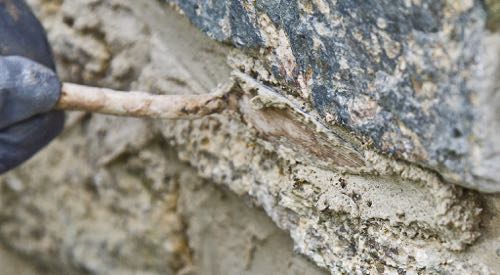The familiar pattern of mortar between the brick or stone of buildings is known as pointing. This mortar material is commonly shaped with the point of the builder’s trowel, hence the name for the procedure, though other tools and implements are also used to give a different shape or texture to the mortar joint. In Cornwall, where old or disused buildings are commonly restored and brought back into use for housing, repointing – as in gouging out old mortar joints and refilling with brand-new mortar – is a common task demanded of restorers, usually at an architect’s insistence. Done sensitively, in a manner which respects and complements both the materials and context of the original building, this operation helps breathe new life into an old weathered homestead. However, a slick-looking ‘proper job’ using modern materials may have disastrous consequences for a wall, which may end up looking no where near the finish you are looking for.
Traditional building techniques
The majority of traditional buildings in the Cornish landscape are constructed from local resources – often stone, cob or brick – assembled, where available, using pervious lime mortar to joint the materials and provide weatherproofing, sometimes with the assistance of a wash or rendering. This method relies upon the lime mortar being softer and more permeable than the surrounding brick- or stonework; and when this is so, the jointing material acts like a sponge, absorbing and releasing moisture in response to climatic conditions. Thus seasonal structural movement can be safely accommodated without compromising the safety of the structure, with the added benefit that such moisture management keeps the weather from penetrating the adjacent building materials, making the whole structure durable and weather-resistant.
Established cottage industry
Though lime was not always accessible or affordable – and it was not uncommon for Cornish buildings to be constructed using an earth and clay mortar between the stones – lime was becoming available in commercial quantities by the eighteenth century. Back then, the lime trade supplied lime for agriculture, lime for building, and to lime create lime wash as a weatherproof coating for stone cottages.
For Cornwall, this meant the maritime importing of lime: pure, non-hydraulic lime shipped from Plymouth to ports on the South-Cornwall coast, and hydraulic lime sourced from South Wales and delivered via North-Cornish ports. Lime processing generally occurred immediately after docking and unloading, and most of Cornwall’s tiny ports had a lime kiln in the vicinity – it has been estimated there were at at least 230 active Cornish kilns servicing the lime trade, almost all occupying coastal sites.
Due to its highly localised manufacture, lime products were diverse in nature: the geology of the raw materials, kiln design, the fuel available for kiln-firing, and the lime burner’s methods all combined to produce a highly individual product. As a consequence, lime mortars used for construction often varied from one district to the next, affecting not only the specific properties of the mortar but also the ‘look’ of the building itself.
Lime substitute
For many reasons, the heyday of lime as a building material was coming to a close around 1900, and modern sand and cement rapidly became the new, ultra-efficient mortar mix – with disastrous consequences for the repair and restoration of traditional buildings. This harder material was impervious to moisture, leaving the newly repointed exterior brick and stone to bear the brunt of the weather, causing immense damage over a relatively short time – exposed, lime-mortared buildings which had withstood south-westerly gales for centuries suddenly had no jointing material to buffer the moisture, and quickly succumbed to damp, frost, moss and more.
Such harsh measures play no part in conservation lime pointing, a skilled task whose purpose is to renew and preserve the structural integrity of a traditional building – whilst leaving no evidence of restorative action.
Guest article by Sean Usher





